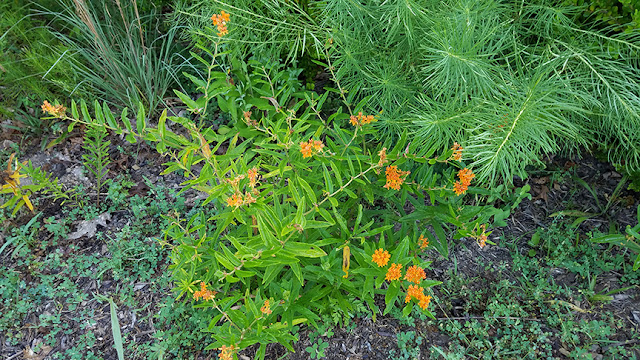 |
| Herb's bed in summer: Clary sage and Blazing Meadow Star |
 |
| Herb's bed another view |
In early summer, despite the voracious deer, my garden is looking splendid. Herb's bed is full of the statuesque flower spikes of Clary Sage, some Blazing Meadow Star and the red Texas sage is beginning to bloom. The lavender is a bit past it now, and so is the butterfly weed, but the Feather Reed grass 'Karl Foerster' is sporting its plumes at the back of the bed.
 |
| Crocosmia 'Lucifer' |
 |
| Crocosmia ;Lucifer' |
I've sprayed most of the plants with deer repellent--despite some browsing, the red Crocosmia 'Lucifer' has retained some of its flowers. I was able to save a few Purple de Oro daylilies too. I finally got to see some blooms on the dwarf Buttonbush 'Sugar Shack', which was planted a few years back, and hadn't had a chance to bloom--deer kept eating the buds. The wild petunia ( Ruelia humilis) usually gets chewed up pretty bad too, but the spray seems to be working.
 |
| Purple de Oro daylilies with rosemary and thyme. |
 |
| Dwarf Buttonbush 'Sugar Shack' |
 |
| Wild petunia (Ruelia humilis). |
Deer usually don't care for iris and the Chinese iris (Blackberry Lily) is no exception.
 |
| Chinese iris AKA Blackberry Lily. |
The deer left me only one flower of the red bee balm (Monarda 'Jacob Kline') and a few Coneflowers in the back bed despite spraying-- I guess these are the areas in my yard most exposed to them.
 |
| Red Monarda 'Jacob Kline' with Anise Hyssop, Mountain mint and Oat grass. |
 |
| Coneflowers and Mountain mint. |
The Vitex shrub is getting ready to bloom in the east garden woodland--its lavender flowers are a wonderful attraction during July. The unidentified hydrangea in front of it needs protection from the deer, as well as the anemone nearby, therefore the barrier.
 |
| Vitex in bud. |
 |
| Mexican Wavy grass (Nasella tenuissima) in the east woodland. |
 |
| The back yard from the east side |
Salvias are another plant that is pretty deer-proof. This summer I'm growing several tropical ones, some new for me: deep purple 'Amistad', a red one called 'Faye Chapel', my favorite 'Black and Blue', and 'Hummingbird Falls' in a hanging basket. Early 'Amistad' is the only one that has any flowers right now.
 |
| Salvia 'May Night' is almost finished for now. |
 |
| Salvia 'Amistad' in a pot along the front walk. |
The trees in my front garden offer welcome shade in the heat, and shelter for potted plants.
 |
| The front garden. |
Petunias are the main feature of my hanging baskets on the porch this year--love that deep purple! The other plants on the porch being kept out of the deer's reach are a Sunpatiens with bicolor leaves, my yellow Hibiscus, and a low-growing Campanula I'll set out in the garden when it cools down a bit.
 |
| Petunias 'Pretty Grand' and 'Madness March' mix. |
 |
| Petunias 'Pretty Grand' and 'Madness March' mix. |
 |
| A Sunpatiens and a low-growing Campanula. |
My Australian Red lime tree has produced one fruit and is blooming nicely.
 |
| Australian red lime. |
Hopefully, the weather will continue to cooperate and I'll have plenty of flowers for July's Bloom Day in a couple of weeks.









































